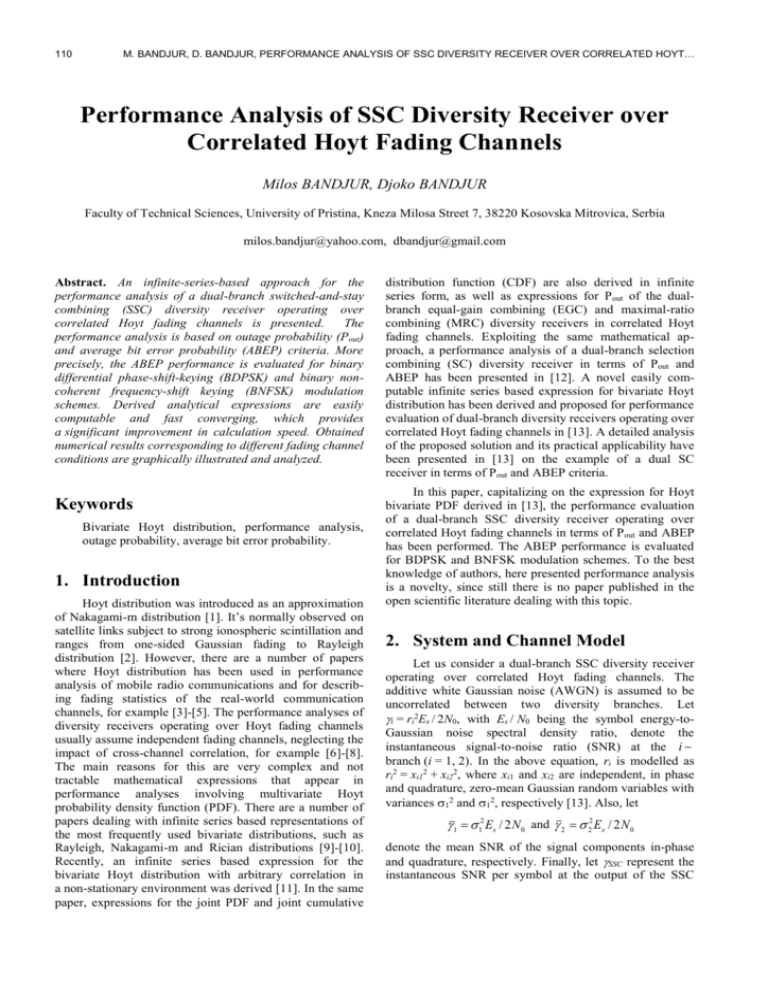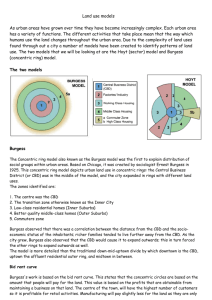Performance Analysis of SSC Diversity Receiver over Correlated
advertisement

110 M. BANDJUR, D. BANDJUR, PERFORMANCE ANALYSIS OF SSC DIVERSITY RECEIVER OVER CORRELATED HOYT… Performance Analysis of SSC Diversity Receiver over Correlated Hoyt Fading Channels Milos BANDJUR, Djoko BANDJUR Faculty of Technical Sciences, University of Pristina, Kneza Milosa Street 7, 38220 Kosovska Mitrovica, Serbia milos.bandjur@yahoo.com, dbandjur@gmail.com Abstract. An infinite-series-based approach for the performance analysis of a dual-branch switched-and-stay combining (SSC) diversity receiver operating over correlated Hoyt fading channels is presented. The performance analysis is based on outage probability (P out) and average bit error probability (ABEP) criteria. More precisely, the ABEP performance is evaluated for binary differential phase-shift-keying (BDPSK) and binary noncoherent frequency-shift keying (BNFSK) modulation schemes. Derived analytical expressions are easily computable and fast converging, which provides a significant improvement in calculation speed. Obtained numerical results corresponding to different fading channel conditions are graphically illustrated and analyzed. Keywords Bivariate Hoyt distribution, performance analysis, outage probability, average bit error probability. 1. Introduction Hoyt distribution was introduced as an approximation of Nakagami-m distribution [1]. It’s normally observed on satellite links subject to strong ionospheric scintillation and ranges from one-sided Gaussian fading to Rayleigh distribution [2]. However, there are a number of papers where Hoyt distribution has been used in performance analysis of mobile radio communications and for describing fading statistics of the real-world communication channels, for example [3]-[5]. The performance analyses of diversity receivers operating over Hoyt fading channels usually assume independent fading channels, neglecting the impact of cross-channel correlation, for example [6]-[8]. The main reasons for this are very complex and not tractable mathematical expressions that appear in performance analyses involving multivariate Hoyt probability density function (PDF). There are a number of papers dealing with infinite series based representations of the most frequently used bivariate distributions, such as Rayleigh, Nakagami-m and Rician distributions [9]-[10]. Recently, an infinite series based expression for the bivariate Hoyt distribution with arbitrary correlation in a non-stationary environment was derived [11]. In the same paper, expressions for the joint PDF and joint cumulative distribution function (CDF) are also derived in infinite series form, as well as expressions for P out of the dualbranch equal-gain combining (EGC) and maximal-ratio combining (MRC) diversity receivers in correlated Hoyt fading channels. Exploiting the same mathematical approach, a performance analysis of a dual-branch selection combining (SC) diversity receiver in terms of Pout and ABEP has been presented in [12]. A novel easily computable infinite series based expression for bivariate Hoyt distribution has been derived and proposed for performance evaluation of dual-branch diversity receivers operating over correlated Hoyt fading channels in [13]. A detailed analysis of the proposed solution and its practical applicability have been presented in [13] on the example of a dual SC receiver in terms of Pout and ABEP criteria. In this paper, capitalizing on the expression for Hoyt bivariate PDF derived in [13], the performance evaluation of a dual-branch SSC diversity receiver operating over correlated Hoyt fading channels in terms of P out and ABEP has been performed. The ABEP performance is evaluated for BDPSK and BNFSK modulation schemes. To the best knowledge of authors, here presented performance analysis is a novelty, since still there is no paper published in the open scientific literature dealing with this topic. 2. System and Channel Model Let us consider a dual-branch SSC diversity receiver operating over correlated Hoyt fading channels. The additive white Gaussian noise (AWGN) is assumed to be uncorrelated between two diversity branches. Let i = ri2Es / 2N0, with Es / N0 being the symbol energy-toGaussian noise spectral density ratio, denote the instantaneous signal-to-noise ratio (SNR) at the i branch (i = 1, 2). In the above equation, ri is modelled as ri2 = xi12 + xi22, where xi1 and xi2 are independent, in phase and quadrature, zero-mean Gaussian random variables with variances 12 and 12, respectively [13]. Also, let 1 12 Es / 2 N 0 and 2 22 Es / 2 N 0 denote the mean SNR of the signal components in-phase and quadrature, respectively. Finally, let SSC represent the instantaneous SNR per symbol at the output of the SSC RADIOENGINEERING, VOL. 21, NO. 1, APRIL 2012 111 diversity receiver, and the predetermined switching threshold. 2.1 The Bivariate Hoyt PDF The PDF of ssc is given by [14] , rssc , f ssc rssc f , . (1) Moreover, rssc () is given in [15, eq. (21b)] as rssc 0 f 1 , 2 , 2 d 2 , i.e. 0 rssc f 1 , 2 , 2 d 2 f 1 , 2 , 2 d 2 4 2 2 k , l , m, n 2 2 0 f 1 2 ( 1, 2 ) 1, 2 where (4) 1, 2 , k , l, m, n k , l , m, n k l 0 ((m k l n k l ) (m k l n k l )) for all other cases k , l , m, n NoT 0 NoT 0 0 1 2 3 4 5 6 7 8 9 1 3 7 13 21 31 43 57 73 91 0 13 74 243 604 1265 2358 4039 6488 9909 Tab. 1. The number of non-zero terms ( NoT 0 ) and the number of equal to zero terms ( NoT 0 ) in (3), for different values of k, l, m and n. 1 1 1 2 1 1 I l I k 2 2 4 ( 1 ) 4 ( 1 ) 2 1 2 1 1 2 k , l , m, n 4 8 16 ((m k l n k l ) (m k l n k l )) Capitalizing on the previous expression, i.e. the function (k, l, m, n), the largest number of terms in (3) is equal to zero, while only a relatively small number of nonzero terms need to be summed in order to obtain the given accuracy [13, Tab. 1] . This is also partially illustrated in the following Tab. 1, where we assumed due to simplicity, but without losing on validity that k = l = m = n k , l , m, n 0 1 2 1 1 1 2 1 1 I n , I m 2 2(1 2 ) 2 ( 1 ) 1 2 1 2 ((k 0 l 0) (k 0 l 0) k l 0) (8) 1, 2 , k , l , m, n k , l , m, n k , l , m, n (3) 1 1 Exp 1 22 4(1 ) 1 2 , 1 , 2 16 2 1 2 (1 2 ) k l mn0 (2) where f1,2 (∙,∙) is the joint PDF of 1 and 2, while f() is the PDF of the SNR of the Hoyt distribution given in [2, eq. (2.11)]. The joint PDF of 1 and 2, based on [13, eq. (6) – (10)] can be expressed in the form of infinite series as In (4) and (5), is the correlation coefficient between 1 and 2, while in (7), and are polar angles of r1 and r2, respectively [13]. After a series of mathematical manipulation, the authors have found and proposed the following closed form solution of the integral in (7) (5) iff k l m n 0, iff one of the parameters is 0, (6) iff two of the parameters are 0, 2.2 The Bivariate Hoyt CDF Similar to [15, eq. (20)], the CDF of ssc, Fssc (), after some manipulations can be expressed as , F , ( , ), F ssc 1 2 (9) F F F ( , ) , 1 , 2 where iff three of the parameters are 0, iff k 0 l 0 m 0 n 0, F 1 , 2 ( , ) 0 0 f 1 , 2 1, 2 d 1d 2 . (10) Cos[2k ]Cos[2l ] 3. Outage Probability Cos[m( )]Cos[n( )]dd . (7) The outage probability of the SSC receiver, Pout, defined as the probability that the SSC receiver output SNR M. BANDJUR, D. BANDJUR, PERFORMANCE ANALYSIS OF SSC DIVERSITY RECEIVER OVER CORRELATED HOYT… 112 falls below a given outage threshold th , can be expressed as Pout th F ssc th . It is straightforward to show that based on (3) - (8), and after some mathematical manipulations, (10) can be expressed as F 1 , 2 ( th , ) k , l , m, n 0 (11) (1 2 ) 1 2 k , l , m, n k , l , m, n 1 2 4 1 2 1 2 n m 2 a c d k ( ) 1 2 2 2(cd )mn 1 2 2( abd )k l n s 2 d n 2 1 2 2bcd l ( n / 2m / 2)1 a ,b ,c ,d 0 (1) mn 22ab k l 1 2a c d k 1 2 a!b!c!d!(a k 1)(b l 1)(c m 1)(d n 1) k , l , m, n k , l, m, n k , l , m, n 0 (1) 2 d n (1 2 ) 2( c d ) m n 2a b k l 2 2(a b d 1) k l n a ,b,c, d 0 2 1 2 mn 2a c d k 1 2 1 2 1 2 2( a b d ) k l n th 1 1 mn 2a c d k 1, 2 4(1 2 ) 1 2 a!b!c!d!(a k 1)(b l 1)(c m 1)(d n 1) (15) mn 2a c d k 1 2 and mn th 1 1 2a c d k 1, 2 4(1 2 ) 1 2 I2 t 0 1 mn 1 . 2b c d l 1, 2 2 4(1 ) 1 2 (12) 1 q 4 t q 1 q 2 1 q 4 I2 mn 2b c d l 1 2 1 exp f d 2 th 4 q 2 2 4 2 t 1 2t t!1 t 1 q 4 q 2 2 4 1 2t , th q 2 (16) where q is the Nakagami-q fading parameter, which ranges from 0 to 1 [2, eq. (2.11)]. 4. Average Bit Error Probability 5. Results and Discussion The ABEP, Pe , can be evaluated by averaging the conditional symbol error probability, Pe(), over the PDF of SSC, i.e. Using (11), the outage performance of a dual-branch SSC receiver operating in correlated Hoyt fading channels have been numerically evaluated. In Fig. 1, the outage performance is plotted as a function of the normalized outage threshold, th / 1 , for several values of . It is Pe Pe f ssc d (13) 0 where Pe() depends on applied modulation scheme. Thus, for BDPSK and BNFSK Pe() = exp(-)/2, where = 1 and = 1/2, respectively [16]. Accordingly, fssc() is the PDF of the SSC receiver output SNR. By using (1), Pe can be expressed as Pe 1 exp rssc d exp f d , (14) 0 th 2 i.e. Pe I1 I 2 , whereby after some straightforward mathematical manipulations I1 and I2 can be expressed respectively as I1 1 exp rssc d 2 0 assumed 1 2 2 and / 1 2.5 dB. As expected, the results show that the outage performance degrades with increase of . By using (13), in Fig. 2 is plotted the ABEP performance for BDPSK and BNFSK modulation schemes, as a function of the input in-phase average SNR per bit, 1 , for several values of . It is assumed 1 2 2 and th = 5 dB. Fig. 2 indicates that the ABEP performance improves as decreases, and better performance of the BDPSK modulation schemes. Additionally, as expected, it is observed for both (11) and (13) that the number of required terms, that need to be summed in order to obtain the given accuracy, increases as the correlation coefficient and/or the ratio 1 / 2 increase. It is a consequence of the fact that the both (11) and (13) are derived from (3), i.e. [13, eq. (6) – (10)]. On RADIOENGINEERING, VOL. 21, NO. 1, APRIL 2012 113 the other hand, it has been also indicated by results presented in Tab. 2. Similarly to analyses presented in [13] and [17], in Tab. 2 the CPU times for (11) are presented and compared, in cases when F1,2 () is given by (12), i.e. by using our method (OM), and (10), i.e. by using the traditional integral expression (TIE), for several values of . The adaptive Fig. 1. Pout of a dual-branch SSC receiver as a function of th / 1 , for several values of . Fig. 2. ABEP of a dual-branch SSC receiver as a function of 1 , for several values of . 0.1 0.3 0.5 0.7 0.9 TIE 47.467 55.186 85.711 175.487 760.466 OM 1.156 3.546 3.703 85.013 486.881 Tab. 2. Comparison of the CPU times (in seconds) for (11), where F1,2 () is given by (12) and (10), for several values of and six significant digits accuracy. numerical integration technique [18] was used for evaluation of (10). In both cases, an accuracy of six significant digits was required. All calculations were performed under the identical conditions, on a system with Intel® Core™2 Duo CPU P9400 at 2.4GHz. The obtained results clearly show that the CPU time is increased proportionally with the correlation, and that (11) is 114 M. BANDJUR, D. BANDJUR, PERFORMANCE ANALYSIS OF SSC DIVERSITY RECEIVER OVER CORRELATED HOYT… evaluated significantly faster by using our method for all values of the correlation coefficient, especially for its lower values. 6. Conclusion A recently published infinite series based expression for bivariate Hoyt distribution has been used for performance evaluation of a dual-branch SSC diversity receiver operating over correlated Hoyt fading channels. The performance is evaluated in terms of the outage probability and the average bit error probability criteria. Derived analytical expressions are also infinite series based, relatively simple for calculation and fast converging. The obtained numerical results, corresponding to different values of the correlation coefficient are graphically presented. Acknowledgements This work has been partially performed within the framework of the project: Performance optimization of energy-efficient computer and communication systems, TR32023, funded by Ministry of Science and Technological Development of the Republic of Serbia. [9] TAN, C. C., BEAULIEU, N. C. Infinite series representations of the bivariate Rayleigh and Nakagami-m distributions. IEEE Transactions on Communications, 1997, vol. 45, no. 10, p. 1159 1161. [10] ZOGAS, D. A., KARAGIANNIDIS, G. K. Infinite-series representations associated with the bivariate Rician distribution and their applications. IEEE Transactions on Communications, 2005, vol. 53, no. 11, p. 1790 - 1794. [11] DE SOUZA, R. A. A., YACOUB, M. D. Maximal-ratio and equalgain combining in Hoyt (Nakagami-q) fading. In IEEE 69th Vehicular Technology Conference VTC Spring 2009. Barcelona (Spain), 2009, p. 1 - 5. [12] DE SOUZA, R. A. A., YACOUB, M. D. Bivariate Nakagami-q (Hoyt) distribution. In Proceedings of IEEE International Conference on Communications, ICC 2009. Dresden (Germany), 2009, p. 1 - 5. [13] BANDJUR, V. D., BANDJUR, V. M. A New approach to bivariate Hoyt distribution and its application in performance analysis of dual-diversity receivers. Wireless Personal Communications, 2010, vol. 63, no. 3, p. 601 - 612. [14] KO, Y.-C., ALOUINI, M.-S., SIMON, M. K. Analysis and optimization of switched diversity systems. IEEE Transactions on Vehicular Technology, 2000, vol. 49, no. 5, p. 1813 - 1831. [15] ABU-DAYYA, A. A., BEAULIEU, N. C. Analysis of switched diversity systems on generalized-fading channels. IEEE Transactions on Communications, 1994, vol. 42, no. 11, p. 2959 -2966. [16] SAGIAS, N. C., ZOGAS, D. A., KARAGIANNIDIS, G. K. Selection diversity receivers over nonidentical Weibull fading channels. IEEE Transactions on Vehicular Technology, 2005, vol. 54, no. 6, p. 2146 - 2151. [17] SAGIAS, N. C., KARAGIANNIDIS, G. K., BITHAS, P. S., MATHIOPOULOS, P. T. On the correlated Weibull fading model References [1] HOYT, R. S. Probability functions for the modulus and angle of the normal complex variate. Bell Systems Technical Journal, 1947, vol. 26, p. 318 - 359. [2] SIMON, M. K., ALOUINI, M. S. Digital Communication Over Fading Channels, 2nd ed. New York: Wiley, 2004. [3] RADAYDEH, R. M. Average error performance of M-ary modulation schemes in Nakagami-q (Hoyt) fading channels. IEEE Communications Letters, 2007, vol. 11, no. 3, p. 255 - 257. [4] YOUSSEF N., WANG C.-X., PATZOLD M. A study on the second order statistics of Nakagami-Hoyt mobile fading channels. IEEE Transactions on Vehicular Technology, 2005, vol. 54, no. 4, p. 1259 - 1265. [5] YOUSSEF, N., ELBAHRI, W., PATZOLD, M., ELASMI, M. On the crossing statistics of phase processes and random FM noise in Nakagami-q mobile fading channels. IEEE Transactions on Wireless Communications, 2005, vol. 4, no. 1, p. 24 - 29. [6] BAID, A., FADNAVIS, H., SAHU, P. R. Performance of a predetection EGC receiver in Hoyt fading channels for arbitrary number of branches. IEEE Communications Letters, 2008, vol. 12, no. 9, p. 627 - 629. [7] FRAIDENRAICH, G., SANTOS FILHO, J. C. S., YACOUB, M. D. Second-order statistics of maximal-ratio and equal-gain combining in Hoyt fading. IEEE Communications Letters, 2005, vol. 9, no. 1, p. 19 - 21. [8] TRUNG, Q. D., HYUNDONG, S., EEN – KEE, H. Error probability of binary and M-ary signals with spatial diversity in Nakagami-q (Hoyt) fading channels. EURASIP Journal on Wireless Communications and Networking, 2007, Article ID 53742, doi:10.1155/2007/53742. and its applications. In IEEE 62nd Vehicular Technology Conference VTC Fall 2005. Dallas (TX, USA), 2005, vol. 4, p. 2149 - 2153. [18] Wolfram Research, Inc. NIntegrate Integration Strategies: Introduction. [Online] Available at: http://reference.wolfram.com/ mathematica/tutorial/NIntegrateIntegrationStrategies.html About Authors ... Milos BANDJUR has received his Ph.D. degree from the Faculty of Technical Sciences, University of Pristina, in 2008. The areas of research interest are digital communications over fading channels, diversity techniques, and mobile radio communications. He acts as a reviewer for several international journals. He is author or coauthor of several papers published in international journals and conference proceedings. Djoko BANDJUR has graduated at the University of Pristina, Department of Electrical Engineering, in 1993. He received the M.Sc. degree from the Faculty of Electronic Engineering, University of Belgrade, in 1998 and the Ph.D. degree from the Faculty of Electronic Engineering, the University of Nis, in 2010. The areas of research interest are digital communications over fading channels, diversity techniques, and mobile radio communications. He acts as a reviewer for several international journals. He is author or RADIOENGINEERING, VOL. 21, NO. 1, APRIL 2012 coauthor of several papers published in international journals and conference proceedings. 115






